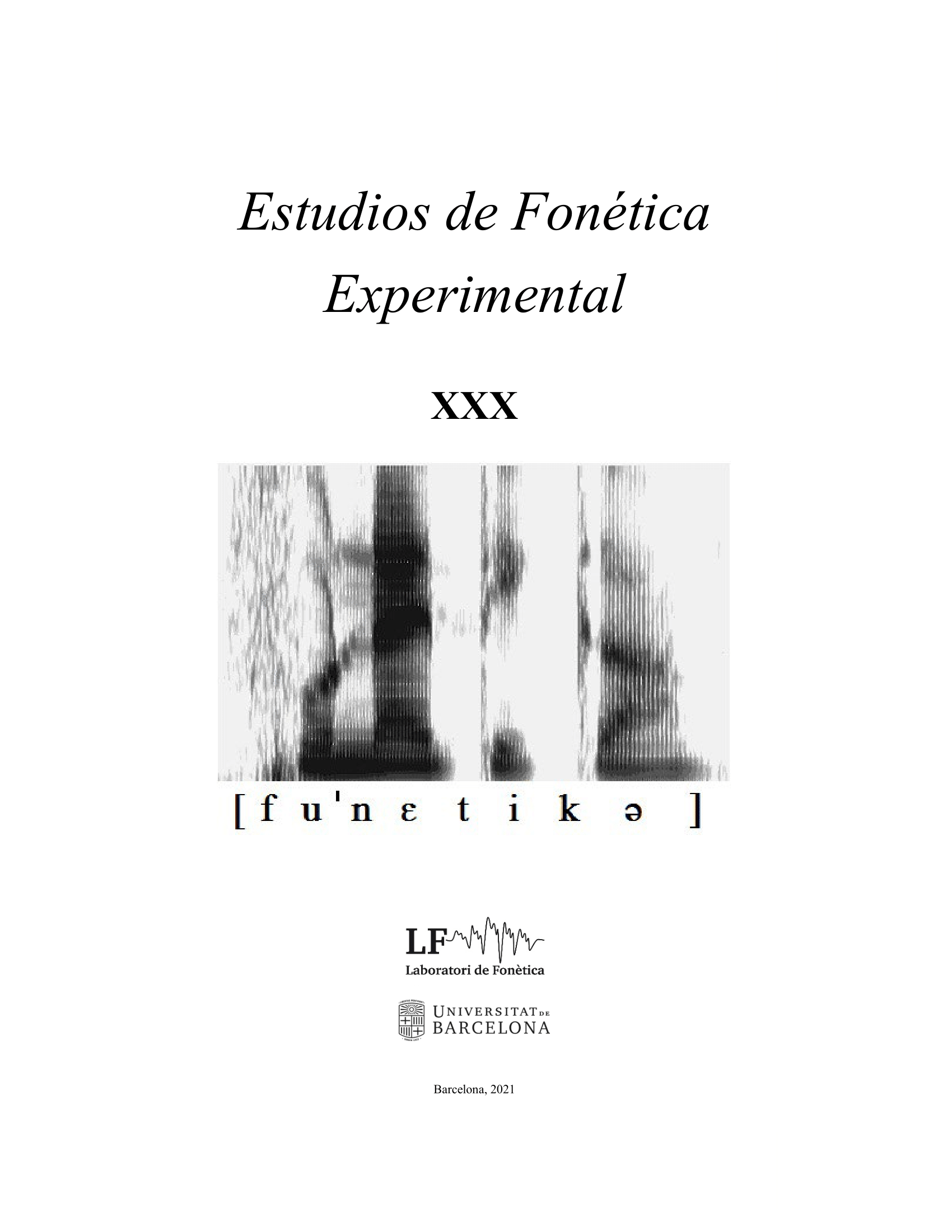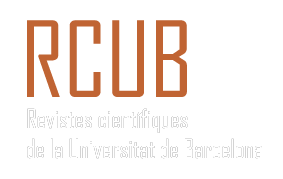VOT in Spanish stops in simulated emotional speech
DOI:
https://doi.org/10.1344/efe-2021-30-35-57Keywords:
Spanish stops, Voice Onset Time, burst, emotions, simulated speechAbstract
The goal in this article is to find out whether VOT in voiced and voiceless stops in Peninsular Spanish varies across different emotional dialogical situations. Ten pairs of female university students from Alicante aged 18-25 years old performed poli-functional simulated dialogue in three different situations: joy, anger, and neutrality. After this phase, we analyzed VOT in the three contexts and then compared our values in the neuter form with those obtained in previous studies. Our results show differences with those from previous research on VOT, which are based on the reading of word lists. The statistical analysis, however, only allows us to point out some inconclusive trends in the influence of the emotions examined.
References
Asensi L., Portolés, S., y Del Río, A. (1997): «Barra de explosión, VOT y frecuencia de las oclusivas sordas del castellano», Estudios de fonética experimental, 9, pp. 221-242.
Beckman, J., Helgason, P., McMurray, B., y Ringen, C. (2011): «Rate effects on Swedish VOT: Evidence for phonological overspecification», Journal of Phonetics, 39(1), pp. 39-49. https://doi.org/10.1016/j.wocn.2010.11.001
Beckman, J., Jessen, M., & Ringen, C. (2013): «Empirical evidence for laryngeal features: Aspirating vs. true voice languages», Journal of Linguistics, 49(2), pp. 259-284. https://doi.org/10.1017/S0022226712000424
Berkson, K. H. (2012): «Capturing breathy voice: Durational measures of oral stops in Marathi», Kansas Working Papers in Linguistics, 33, pp. 27-46. https://doi.org/10.17161/KWPL.1808.10495
Boersma, P. y Weenik, D. (2019): Praat v.6.0.37 [10/05/2020].
Borzone, A. M. (1980): Manual de fonética acústica, Buenos Aires: Editorial Hachette.
Castañeda Vicente, M. L. (1986): «El V.O.T. de las oclusivas sordas y sonoras españolas», Estudios de fonética experimental, 2, pp. 91-110.
Déniz, M. T. (2005): «El VOT de las oclusivas sordas en la norma culta de Las Palmas de Gran Canaria», Boletín de Lingüística, 24, pp. 92-107.
Ekman, P. (1970): «Universal Facial Expressions of Emotions», California Mental Health Research Digest, 8(4), pp. 151-158.
Ekman, P. (1999): «Basic emotions», en T. Dalgleish y M. Power (eds.): Handbook of Cognition and Emotion, 98(16), pp. 45-60. https://doi.org/10.1002/0470013494.ch3
Field, A. (2009): Discovering Statistics Using SPSS, London: SAGE Publications.
Fry, D. B. (1979): The physics of speech, Cambridge University Press. https://doi.org/10.1017/CBO9781139165747
Garrido, J. M. (2019): «Análisis de las curvas melódicas del español en el habla emotiva simulada», Estudios de Fonética Experimental, 20, pp. 205-55.
Helgason, P., y Ringen, C. (2008): «Voicing and aspiration in Swedish stops», Journal of phonetics, 36(4), pp. 607-628. https://doi.org/10.1016/j.wocn.2008.02.003
Herrera, J. (1997): «Estudio acústico de /p, t, c, k/ y /b, d, y, ɡ/ en Gran Canaria», en M. Almeida y J. Dorta (eds.): Contribuciones al estudio de la lingüística hispánica: Homenaje al profesor Ramón Trujillo, Barcelona: Montesinos, pp. 73-86.
Hualde, J. I. (2014): «Lenición de obstruyentes sordas intervocálicas en español: estado de la cuestión», en Y. C. Martín, Mª L. M. Curiel y A. S. Plans (eds.): Fonética Experimental, Educación Superior e Investigación, Madrid, Arco Libros, 1, pp. 113-136.
Hunnicutt, L., y Morris, P. A. (2016): «Prevoicing and Aspiration in Southern American English», University of Pennsylvania Working Papers in Linguistics, 22(1), 24.
Kessinger, R. H., y Blumstein, S. E. (1997): «Effects of speaking rate on voice-onset time in Thai, French, and English», Journal of Phonetics, 25(2), pp. 143-168. https://doi.org/10.1006/jpho.1996.0039
Ladefoged, P., y Johnson, K. (2006): A course in phonetics (5th), Thomson Wadsworth.
Ladefoged, P., y Maddieson, I. (1996): The Sounds of the World's Languages, Oxford: Blackwell.
Lewis, A. M. (2000): «Acoustic variability of intervocalic voiceless stop consonants in three Spanish dialects», en Hispanic linguistics at the turn of the millennium: papers from the 3rd Hispanic Linguistics Symposium 2000, Cascadilla Press, pp. 101-114.
Lexicon of Linguistics: https://lexicon.hum.uu.nl/ [10/05/2020].
Lisker L., y Abramson A. S. (1964): «A Cross-Language Study of Voicing in Initial Stops: Acoustical Measurements», WORD, 20:3, pp. 384-422. https://doi.org/10.1080/00437956.1964.11659830
Machuca, M. J. (1997): «Las obstruyentes no continuas del español: relación entre las categorías fonéticas y fonológicas en el habla espontánea», tesis doctoral inédita, Universitat Autònoma de Barcelona.
Magloire J., y Green K. P. (1999): «A Cross-Language Comparison of speaking rate effects on the production of voice onset time in English and Spanish», Phonetica, 56(3-4), pp. 158-185. https://doi.org/10.1159/000028449
Martínez Celdrán, E. (1984): Fonética, Barcelona, Teide.
Martínez Celdrán, E., y Fernández Planas, A. M. (2007): Manual de fonética española: articulaciones y sonidos de español, Editorial Ariel.
Martínez Celdrán, E. (2009): «Sonorización de las oclusivas sordas en una hablante murciana: Problemas que plantea», Estudios de fonética experimental, 18, pp. 254-271.
Martínez Celdrán. E. (en prensa): «Fonética y fonología descriptivas de la lengua española», en J. Gil y J. Llisterri (eds.): fonética y fonología descriptivas de la lengua española (en prensa: Georgetown University Press).
Martínez Celdrán, E. (2013): «Los sonidos obstruyentes en la cadena hablada», en M. A. Peñas Ibáñez (ed.): Panorama de la fonética española actual, Madrid, Arco/Libros SL, pp. 253-289.
Morales del Valle, H. H. (2006): La estratificación social de las variantes del grupo consonántico /ks/ en el español de estado de Guanajuato, trabajo final de grado, Universidad de Guanajuato, México.
Morris, P. A. (2018): «Rate effects on Southern American English VOT», Proceedings of the Linguistic Society of America 2018, 3(1), 60:1-10. https://doi.org/10.3765/plsa.v3i1.4310
Natarina, A. (2019): «A VOT study of the acquisition of English stop contrasts by Marathi speakers: the mutual influence of L1 and L2», en A.A.P. Belda, H. Galbraith, K. Josephs, A. P. Pinto, E. Pulkowski, K. Walker-Cecil y C. Wuxiha (eds.): Research Approaches to Second Language Acquisition: Proceedings of the 2018 Second Language Acquisition Graduate Student Symposium (CARLA Working Paper Series). Minneapolis: University of Minnesota, The Center for Advanced Research on Language Acquisition, pp-39-64.
Padilla, Xose A. (2017): «Prosodia y (des)cortesía en contexto de diálogo: la creación y la negociación del ámbito tonal», LEA, 39(2), pp. 243-268.
Padilla, Xose A. (2020): «Prosodia emocional y conversación espontánea: bases para el establecimiento de un protocolo de identificación perceptiva», Phonica, 16, pp.4-35. https://doi.org/10.1344/phonica.2020.16.4-35
Padilla, Xose A. (2021): «La voz como reacción emocional: de qué nos informa la prosodia», Spanish in Context (en prensa). https://doi.org/10.1075/sic.20029.pad
Piñeros, C. E. (2008): Estructura de los sonidos del español. Pearson Prentice Hall.
Plutchik, R. (1994): «Emotion: Theory, research, and experience», Theories of emotion, 1, New York: Academic.
Poch, M. D. (1984): «Datos acústicos para la caracterización de las oclusivas sordas del español», Folia Phonetica, 1, pp. 89-106.
Roldán, Y., y Soto-Barba, J. (1997): «El VOT de /ptk/ y /bdɡ/ en el español de Valdivia: un análisis acústico», Estudios filológicos, 32, pp. 27-33. https://doi.org/10.4067/S0071-17131997003200003
Rosenthal, R. (1991): Metaanalytic procedures for social research (2nd ed.), Newbury Park, CA: Sage.
Rosenthal, R., Rosnow, R. L., y Rubin, D. B. (2000): Contrasts and effect sizes in behavioural research: a correlational approach, Cambridge: Cambridge University Press. https://doi.org/10.1017/CBO9780511804403
Rosner B. S., López-Bascuas, L. E., García-Albea, J. E., y Fahey, R. P. (2000): «Voice-onset times for Castilian Spanish initial stops», Journal of Phonetics, 28(2), pp. 217-224. https://doi.org/10.1006/jpho.2000.0113
Rosnow, R. L., y Rosenthal, R. (2005): Beginning behavioural research: a conceptual primer (5th ed.). Englewood Cliffs, NJ: Pearson/Prentice Hall.
Scherer, K. R., Ladd, D. R. y Silverman, K. E. (1984): «Vocal cues to speaker affect: Testing two models», The Journal of the Acoustical Society of America, 76(5), pp. 1346-1356. https://doi.org/10.1121/1.391450
Shea, C., y Curtin, S. (2006): «Learning allophonic alternations in a second language: Phonetics, phonology and grammatical change», en M. G. O'Brien, C. Shea y J. Archibald (eds.): Proceedings of the 8th Generative Approaches to Second Language Acquisition Conference (GASLA 2006), Somerville, MA: Cascadilla Proceedings Project, pp. 124-131.
Shea, C. E., y Curtin, S. (2011): «Experience, representations and the production of second language allophones», Second Language Research, 27(2), pp. 229-250. https://doi.org/10.1177/0267658310375753
Slis, I.H. (1971): «Articulatory effort and its durational and electromyographic correlates», Phonetica, 23, pp. 171-188. https://doi.org/10.1159/000259338
Downloads
Published
How to Cite
Issue
Section
License
Copyright (c) 2021 Juan C. Martínez-Belda, Xose A. Padilla

This work is licensed under a Creative Commons Attribution-NonCommercial-NoDerivatives 4.0 International License.
All articles published online by Estudios de Fonética Experimental are licensed under Creative Commons Attribution-NonCommercial-NoDerivs 4.0 International (CC BY-NC-ND 4.0 DEED), unless otherwise noted. Estudios de Fonética Experimental is an open access journal. Estudios de Fonética Experimental is hosted by RCUB (Revistes Científiques de la Universitat de Barcelona), powered by Open Journal Systems (OJS) software. The copyright is not transferred to the journal: authors hold the copyright and publishing rights without restrictions. The author is free to use and distribute pre and post-prints versions of his/her article. However, preprint versions are regarded as a work-in-progress version used as internal communication with the authors, and we prefer to share postprint versions.




